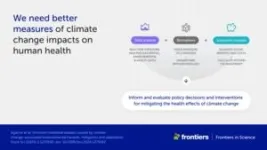(Press-News.org) Even in nature, pride can prevail. A study with researchers from the University of Gothenburg shows that sea anemones that react more slowly to change can survive a heatwave better than individuals that change their behaviour quickly.
Along the Atlantic coasts of Europe, many species are exposed to abrupt shifts in habitat. Tides, storms and rapid temperature changes are commonplace for the marine species that live there. With climate change, heatwaves are expected to become more frequent, and researchers wanted to find out how coastal marine species cope with extreme water temperatures. They chose to study the sea anemone species Actinia equina, a species that exhibits individual behaviours.
Brave or shy
“We call them animal personalities. They are different behavioural life strategies found in the same species. The anemones we studied have two personality traits, bold and shy, and in extreme heat waves the shy anemones do better,” says Lynne Sneddon, a zoophysiologist at the University of Gothenburg and co-author of the study published in the Journal of Experimental Biology.
Being a shy or bold anemone describes the individual's risk-taking. Both behaviours have advantages that have made them winners in evolution, otherwise they would not exist. A bold anemone reacts more quickly to changes in the environment than a shy anemone does. This means that the bold ones are quicker than the shy ones to open their tentacles to forage after a change. The bold anemones can trap more of the nutrients in the water, and this gives them a competitive advantage. On the other hand, they become more vulnerable in extreme conditions, such as heat waves. The researchers' study shows that being a shy individual is a better survival strategy when the water is extremely hot.
“We measured the metabolism of the anemones and could see that when the water temperature was high, the metabolism of the bold anemones skyrocketed. This meant that they had to increase their nutrient intake so much that they risked dying. The shy anemones' metabolism increased less, so they were better able to cope with the heat stress,” says Lynne Sneddon.
Rapid warming at low tide
In coasts with large tidal differences, water collects in “rock pools” that warm up quickly on the ebb tide before the next flood washes in with colder seawater. Anemones living in these pools are therefore particularly vulnerable to large temperature differences.
“Heat waves will become more common in the future and cold-blooded animals may find it difficult to cope. We studied anemones, but we have reason to believe that the phenomenon applies to other species as well. If the animals can't cope, there will be a disruption in the ecosystems and this could have implications for the whole food web,” says Lynne Sneddon.
END
Shy sea anemones are more likely to survive heatwaves
2024-04-04
ELSE PRESS RELEASES FROM THIS DATE:
Researchers at UMass Amherst are listening in on the world’s rulers—insects—to better gauge environmental health
2024-04-04
AMHERST, Mass. – Recent research led by the University of Massachusetts Amherst evaluates how well machine learning can identify different insect species by their sound, from malaria-carrying mosquitoes and grain-hungry weevils to crop-pollinating bees and sap-sucking cicadas. Listening in on the insect world gives us a way to monitor how populations of insects are shifting, and so can tell us about the overall health of the environment. The study, published in the Journal of Applied Ecology, suggests that machine and deep learning are becoming the gold standards for automated ...
Climate change impacts terrorist activity
2024-04-04
Changing weather patterns induced by climate change are contributing to shifts in the location of terrorist activity, according to new research.
An exploratory study led by extremism expert Dr Jared Dmello, from the University of Adelaide’s School of Social Sciences, found some climatological variables affected terrorist activity in India.
“Suitability analyses indicate that all the climatological variables tested – temperature, precipitation, and elevation – relate to shifting patterns of terrorist activity,” says Dr Dmello.
“Urban centres have increasingly grown in population ...
Exercise habits in youth create better health outcomes for some
2024-04-04
Forming a long-term recreational exercise habit as a young person has a beneficial impact on physical and mental health later in life, but some groups, such as females and academic high-achievers, miss out on these benefits disproportionately.
A University of Adelaide study found females, people with low self-efficacy, reluctant exercisers, higher academic achievers, and those experiencing socioeconomic disadvantage are all most at risk of failing to establish regular exercise patterns during the transition from adolescence to young adulthood.
The finding was made by examining data collected as part of the Longitudinal Survey of Australian ...
Researchers uncover a potential method for interrupting the misfolding of tau protein that underlies neurodegenerative disease
2024-04-04
(Santa Barbara, Calif.) — A spectrum of neurodegenerative diseases, including frontotemporal dementia (FTD), progressive supranuclear palsy (PSP) and corticobasal degeneration (CBD) are due to the accumulation of abnormal, misfolded tau proteins in the brain. A team of researchers led by UC Santa Barbara scientists has found potential ways to interrupt this process by targeting “sticky” sites along the long form of mutated tau, preventing the misfolding and spreading of the neurofibrillary tangles.
“This is ...
UT Health San Antonio establishes Be Well Institute on Substance Use and Related Disorders
2024-04-04
SAN ANTONIO, April 3, 2024 – The University of Texas Health Science Center at San Antonio (UT Health San Antonio) is establishing the Be Well Institute on Substance Use and Related Disorders, a pioneering initiative dedicated to advancing research, education and evidence-based treatments.
The new institute includes the current Be Well Texas initiative of UT Health San Antonio as part of a new overall comprehensive center of excellence with national scope for research, clinical and public health programs, as well as education and community engagement to advance the field addressing addiction and related conditions.
The goal of the Be Well Institute is to be a nationally premiere substance ...
Study finds high amounts of silica exposure in previously deployed military veterans
2024-04-04
Since the conflicts that followed 9/11 in 2001, military veterans deployed to areas in Southwest Asia, Iraq, Afghanistan, and the Horn of Africa have been developing respiratory diseases caused by inhaling particulate matter linked to their deployment locations and job duties. New research published in the International Journal of Environmental Research and Public Health shows levels of silica and other silicates are significantly higher in the lungs of those who have had past deployments compared to normal lung tissue.
“Using ...
Life expectancy increased as world addressed major killers including diarrhea, lower respiratory infections, and stroke
2024-04-04
Global life expectancy increased by 6.2 years since 1990 according to a new study published in The Lancet. Over the past three decades, reductions in death from leading killers fueled this progress, including diarrhea and lower respiratory infections, as well as stroke and ischemic heart disease. When the COVID-19 pandemic arrived in 2020, however, it derailed progress in many locations. This is the first study to compare deaths from COVID-19 to deaths from other causes globally.
Despite the challenges presented by the COVID-19 pandemic, the researchers found that the super-region of Southeast Asia, East Asia, and Oceania had the largest net ...
Research shows direct link between state income taxes and migration
2024-04-04
After the introduction of the income tax in the United States, there has been a migration of higher income earners toward states with lower or no income tax, a new study reveals.
This first-ever systematic analysis of 110 years of state income tax implementation throughout the United States also highlights the consequences of taxpayers fleeing to low or no-tax states. Published in the American Economic Journal: Economic Policy, the study is titled “The Introduction of the Income Tax, Fiscal Capacity, and Migration: Evidence from U.S. States” and was coauthored by Ugo Antonio Troiano, economist and associate ...
SynGAP Research Fund (SRF) appoints Kathryn Helde, PhD, as Chief Scientific Officer (CSO) focusing on SYNGAP1 research
2024-04-04
Mill Valley, CA – April 4, 2024 – SynGAP Research Fund 501(c)(3), the leading patient advocacy group working to improve the lives of SYNGAP1-Related Disorder (SRD) patients, today announced the appointment of Kathryn Helde, PhD, as its Chief Scientific Officer, effective February 1, 2024.
“SRF’s scientific grantmaking, industry partnerships, and repurposing efforts have grown past the point where we need a dedicated CSO,” says Mike Graglia, SRF’s Co-Founder and Managing Director. “We are fortunate to have a parent in our ranks who is as well trained, talented, and dedicated as Dr. Helde. As a volunteer for years, ...
Recent contact with young children linked to trebling of risk of over-60s acquiring pneumonia-causing bacteria
2024-04-04
Findings from US longitudinal household study add to ongoing US vaccination policy discussions by suggesting that pneumococcal vaccination in older adults is important even in populations where children are vaccinated at high rates.
**Note: the release below is a special early release from the European Congress of Clinical Microbiology and Infectious Diseases (ECCMID 2024, Barcelona, Spain, 27-30 April). Please credit the congress if you use this story**
New research being presented at this year’s European Congress of Clinical Microbiology and Infectious Diseases (ECCMID 2024) in Barcelona, Spain (27-30 April) finds that pneumonia-causing ...






